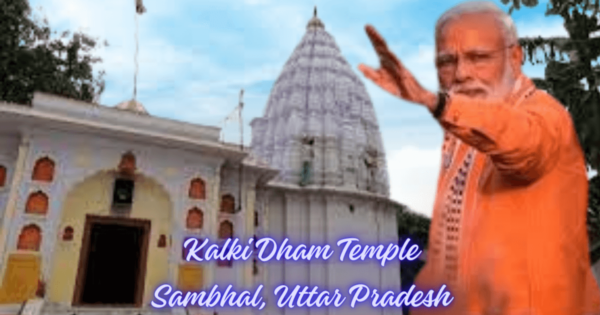The foundation stone of the Kalki Dham Temple in Sambhal, Uttar Pradesh, was laid by Prime Minister Narendra Modi on 19th Feb 2024 in a historic ceremony that expressed spiritual zeal and communal peace. This historic event not only marks the realization of religious goals but also the beginning of a new era in the economic, social, and cultural history of the region. In this article “Kalki Dham Temple: A Symbol of Unity and Progress in Sambhal, Uttar Pradesh”, we will discover the importance and specification of the holy temple.
Table of Contents
Kalki Dham Temple – Historical and Religious Significance:
The temple known as Kalki DhamTemple, dedicated to Lord Kalki, the future avatar of Lord Vishnu in Hindu mythology, is a monument to the rich religious legacy of India. Its design, which harmoniously combines modern and traditional elements, symbolizes the respect for spiritual sanctuaries that exists beyond the rapid growth of society.
The Kalki Dham temple’s beginnings can be found in ancient books and predictions that predict Lord Kalki’s arrival as the messenger of justice and the establishment of cosmic harmony. The temple’s elaborate motifs and symbolism are reflected in its architectural design, which reflects the great spiritual value attached to Lord Kalki and his role in the periodic cycles of creation, preservation, and dissolution.
Prime Minister’s Involvement:
The active involvement of Prime Minister Narendra Modi in the ceremony of kalki Dham Temple demonstrates the government’s ongoing commitment to promoting acceptance of religion and cultural protection. Millions of followers find their dreams fulfilled by his presence, which represents a common goal of achieving both social and spiritual advancement.
The government’s proactive approach in supporting the preservation of cultural assets and creating a favorable atmosphere for religious expression and spiritual development is reflected in PM Modi’s leading involvement in the project. During his speech at the event, Prime Minister Modi emphasized the value of religious respect and kindness for one another, emphasizing the role that cultural variety has in shaping India’s national character and collective awareness.
Collaborative Endeavors:
During the foundation stone-laying event, a wide range of interested groups came together to pursue a shared objective, including community members, religious leaders, and government representatives. This group effort, which crosses religious and ideological lines for the benefit of society as a whole, is an excellent example of cooperation and unity.
The cooperation goes beyond the ritualistic side and included the planning, designing, and building stages of the temple, demonstrating the cooperation of different organizations toward a common goal. The inclusion of local artists and craftsmen in the building stage emphasizes the importance of preserving traditional skills and craftsmanship, ensuring the authenticity and cultural integrity of the temple’s architectural elements.
